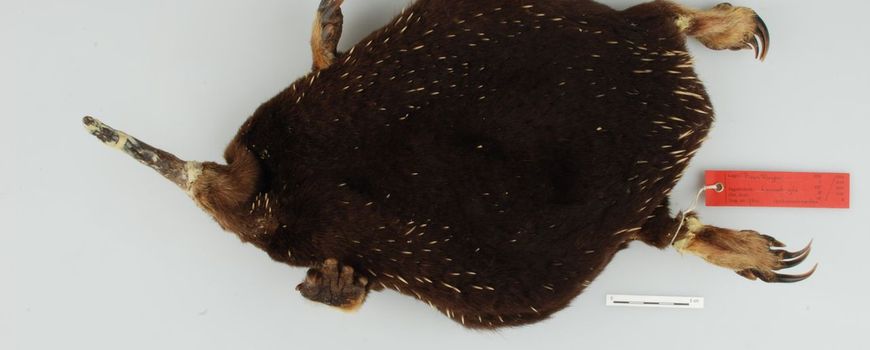Naturalis is known as a museum, but the institute’s natural history collection is more than a thousand times larger than what is on display. Far behind the scenes of the museum is the Treasury, with the crème de la crème of that group. Here Naturalis keeps the most scientifically important specimens from our animal collections, as well as specimens of extinct species. It is sacred ground, rarely visited even by Naturalis employees. It is also a rather sad memorial to disappearing animals. Here, mounted specimens of bluebuck, ivory-billed woodpecker, and marsupial wolf stand near a dodo skeleton. All types that can only be seen in museums.
Unique copy
One of the rare items here is the fur (and a piece of the skull) of Attenborough’s furry hedgehog, Zaglos Attenborough. It is unique: exactly one copy is known in the whole world. Collected in Papua in the 1960s. In 1998, biologists decided it was a new species. They named it after British documentary filmmaker Sir David Attenborough, for his role in protecting and publicizing Papua’s wildlife. Descriptors of this species have never seen it alive. As far as we know, the last person to do so was Naturalis scientist Peter van Rooyen who collected this specimen in 1961.
No one until this week. Because on the last day of their journey, a British expedition’s automatic camera photographed something no one had seen since 1961: a living specimen of this species.
The extinct furry hedgehog was searched for and found (Source: Reuters)
protection
Good news for everyone who loves echidna! And who isn’t? They lay eggs, have a spiked coat and a toothless snout. It is assumed that females of this species have a pouch, but we do not know this because the only known specimen is a male.
This species does not appear to become extinct after 62 years, as was previously thought. That’s still shorter than Naturalis’ Emmalia black-browed mouse, which has been the sole representative of its species for 172 years. “We hope this will inspire people to better protect nature in the Cyclops Mountains, where this species lives,” said group director Bibijen Kammenga.
Since this specimen was the only one of its kind, it is therefore automatically called a holotype: the specimen used to describe a species. Naturalis never displays models in a museum, because they must be available for scientific research.
Text and images: Natural Biodiversity Centre (Main image: A sample of Attenborough’s furred hedgehog in the Naturalis Collection)
Video: Reuters

“Lifelong food practitioner. Zombie geek. Explorer. Reader. Subtly charming gamer. Entrepreneur. Devoted analyst.”












More Stories
Revealing the ten countries that support Ukraine the most
Funny protest against mass tourism in Galician village
Kamala Harris has wind in her sails, but Trump can still win